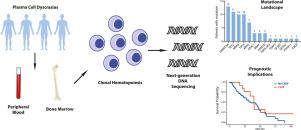Seminars in Oncology ( IF 4 ) Pub Date : 2022-12-01 , DOI: 10.1053/j.seminoncol.2022.11.001 Stefano Testa 1 , Jyoti Kumar 2 , Alex J Goodell 3 , James L Zehnder 2 , Kevin M Alexander 4 , Surbhi Sidana 5 , Sally Arai 5 , Ronald M Witteles 4 , Michaela Liedtke 6

|
Clonal hematopoiesis of indeterminate potential (CHIP) is common both in healthy individuals and patients with hematological cancers. Recent studies have showed worse prognosis for patients with multiple myeloma (MM) and non-Hodgkin lymphoma undergoing stem cell transplant, that have concomitant presence of CHIP. Data regarding the clinical and biological role of CHIP in plasma cell dyscrasias (PCDs) is rapidly increasing. However, the prevalence and prognostic implication of CHIP in patients with MM outside of the transplant setting, and in those with other more indolent PCDs remains elusive. Here we explored the prevalence and clinical implications of CHIP detected through next-generation sequencing in 209 patients with PCDs including MM, light chain (AL) amyloidosis (ALA), monoclonal gammopathy of undetermined significance (MGUS), and smoldering multiple myeloma (SMM). To avoid attributing the mutations to the plasma cell clone, CHIP was defined as the presence of DNMT3A, TET2, or ASXL1 mutations in the peripheral blood or bone marrow (DTA-CH). The prevalence of DTA-CH was 19% in patients with PCDs, with no difference between each PCD. TET2 (23%) and DNMT3A (22%), were the most frequently mutated genes. DTA-CH correlated with older age in MM (P = .001) and MGUS/SMM (P = 0.0007), as well as with coronary artery disease or congestive heart failure in MM (P = .03). DTA-CH did not predict worse OS or PFS in either MM or ALA, nor it predict higher risk of progression to MM in patients with MGUS/SMM. Our results overall further elucidate the prevalence and mutational spectrum of CHIP in PCDs, providing more information regarding the clinical relevance of CHIP in this patient population.
中文翻译:

浆细胞恶液质中不确定潜能的克隆性造血的患病率、突变谱和临床意义
不确定潜能的克隆性造血 (CHIP) 在健康个体和血液癌症患者中都很常见。最近的研究表明,接受干细胞移植的多发性骨髓瘤 (MM) 和非霍奇金淋巴瘤患者的预后更差,同时存在 CHIP。有关 CHIP 在浆细胞恶液质 (PCD) 中的临床和生物学作用的数据正在迅速增加。然而,CHIP 在移植环境外的 MM 患者以及患有其他更惰性 PCD 的患者中的患病率和预后意义仍然难以捉摸。在这里,我们探讨了通过下一代测序在 209 名 PCD 患者中检测到的 CHIP 的患病率和临床意义,这些 PCD 包括 MM、轻链 (AL) 淀粉样变性 (ALA)、意义未明的单克隆丙种球蛋白病 (MGUS)、和闷烧型多发性骨髓瘤(SMM)。为了避免将突变归因于浆细胞克隆,CHIP 被定义为存在外周血或骨髓 (DTA-CH) 中的DNMT3A、TET2或ASXL1突变。DTA-CH 在 PCD 患者中的患病率为 19%,每个 PCD 之间没有差异。TET2 (23%) 和DNMT3A (22%) 是最常见的突变基因。DTA-CH 与 MM 中的年龄较大 ( P = .001) 和 MGUS/SMM ( P = 0.0007) 以及 MM 中的冠状动脉疾病或充血性心力衰竭相关 ( P =.03)。DTA-CH 既不能预测 MM 或 ALA 患者的 OS 或 PFS 更差,也不能预测 MGUS/SMM 患者进展为 MM 的风险更高。我们的结果总体上进一步阐明了 CHIP 在 PCD 中的患病率和突变谱,提供了有关 CHIP 在该患者人群中的临床相关性的更多信息。



























 京公网安备 11010802027423号
京公网安备 11010802027423号